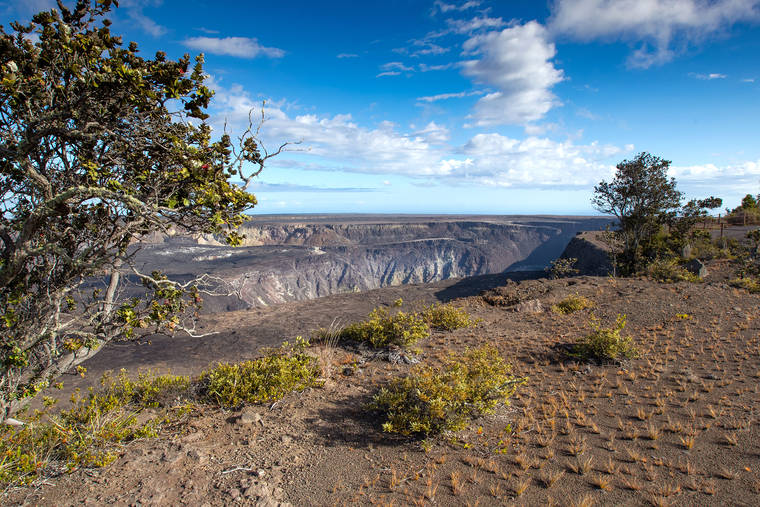With the COVID-19 pandemic once again severely limiting travel to the Big Island, Hawaii Volcanoes National Park has taken advantage of fewer visitors to quietly repair and reopen parts of the park closed since the 2018 Kilauea eruption.
Park spokeswoman Jessica Ferracane said that while HVNP could not immediately provide daily visitation statistics, it is clear that the number of visitors to the park has dropped dramatically. And after Tuesday’s reinstatement of a 14-day mandatory quarantine for interisland travelers, people now visiting the park are primarily Big Island residents.
With the number of visitors so low, the park has been able to complete several eruption-repair projects over the last few months. Hilina Pali Road is now open from Chain of Craters Road to the also-reopened Kulanaokuaiki Campground after repairs were made to the cracked road surface, while Chain of Craters Road itself also is open all the way to Holei Sea Arch after workers installed new guard rails and filled cracks last week, Ferracane said.
Meanwhile, a new pedestrian bridge near Kilauea summit is nearing completion, as are repairs to barriers near the crater’s edge.
Ferracane says the park hopes to reopen Kilauea Overlook, as well as Crater Rim Trail to the overlook, by the end of the month.
While some new areas of the park are open, other parts are closed to prevent the spread of COVID-19.
Currently, the Kilauea Visitor Center and Volcano House are closed, as is Thurston Lava Tube and other points of interest, and ranger-guided hikes and programs are suspended.
Although the park has been able to take advantage of the lack of travelers, the surrounding community has not been as lucky.
Janet Coney, manager of Kilauea Lodge and Restaurant, said the lodge’s occupancy rate is worse than it was during the 2018 eruption, hovering at about 35% occupancy, compared to an occupancy of 44% the July following the eruption.
“At least with the eruption, there were still people from out of state coming here,” Coney said.
With quarantines reinstated for interisland travel to the Big Island, Coney said business is now dependent primarily on West Hawaii residents visiting Volcano for the cooler weather, although she added that many of her customers had assumed the lodge had closed because of the pandemic.
Ira Ono, president of Volcano tourism advocacy group Experience Volcano, said attendance at his art gallery and restaurant has fallen so low that the restaurant can only open on weekends, when marginally more people visit Volcano.
“At this point, all of our reservations are coming from Kona,” Ono said.
However, Ono said there is some good news.
Experience Volcano held its “Second Saturday” event — a monthly community event wherein Volcano businesses hold special sales and other offerings — last week for first time in months, and was able to attract visitors from around the island, he said.
However, Volcano businesses also have had to make social distancing concessions on top of having reduced customers.
Coney said her dining room has been reduced from 21 tables to nine tables, and masks are required everywhere except when seated.
Similar requirements have been imposed at the park. HVNP guests also are urged to practice social distancing, wear face coverings and to not visit if they feel sick.
So far, guests have adhered to COVID-19 guidelines, Ferracane and Coney said.
“We’re not really here to enforce these rules, but people have been good so far,” Ferracane said. “If it weren’t for the out-of-state travel shutdown, it would probably be a lot worse. Everyone’s been understanding and patient with us.”
For the most part, Ferracane said, most social distancing violations within the park happen when guests attempt to ask questions of park rangers and unthinkingly break the 6-foot social distancing guideline, which the rangers then gently correct.
While state parks on Oahu have been closed in response to an ongoing surge of cases there, national parks close at the discretion of the National Park Service.
Denise Adamic, regional spokesperson for the National Park Service, said the NPS will determine whether to close a park based on guidance from the U.S. Centers for Disease Control and Prevention, state and local health guidelines, and unique needs of individual parks.
So far, despite the growing number of cases and the closure of state and county parks on Oahu, the Pearl Harbor National Memorial remains open in a limited capacity.
Email Michael Brestovansky at mbrestovansky@hawaiitribune-herald.com.

